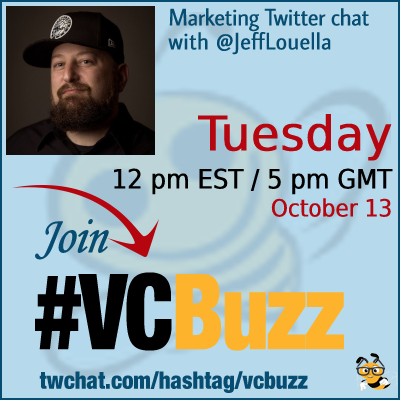
We know that most redesigns are usually the worst SEO nightmare and the ideal scenario is when there’s always an SEO overseeing the process.
More often than not, this is not the case though.
In most cases, SEOs are presented with the redesigned website after the fact and have to deal with its new structure and possibly traffic drops.
What to do? Where to start your redesigned SEO audit?
Let’s discuss!
***Add #VCBuzz chats to your calendar here.
***Please sign in here to follow the chat -> twchat.com/hashtag/vcbuzz
About @JeffLouella
.@JeffLouella is tech SEO at @wirecutter / @nytimes, moderator at /r/TechSEO, co-host of The Page 2 Podcast as well as developer of Quick Click Website Audit Chrome extension.
Check out Jeff’s website: thetechseo.com
Questions we discussed
Q1 How did you become a digital marketer? Please share your career story!
I went to school for 3D Animation in the mid-’90s and took an HTML class. I loved it. Started building my own sites. Got hired at a small startup company. Worked with amazing people. I kept evolving and went from Designer, to Developer, to SEO.
I also love data. Data is key to being a good marketer.
A1: My path to becoming a digital marketer started when I dropped all my accounting classes due to boredom & switched to marketing. One year later, I found a home with @RankMediaAgency & worked with the most talented group of people. I discovered a new passion. ? #vcbuzz https://t.co/tEjBurG679
— Jonathan Berthold (@j_bertho) October 13, 2020
Q2 What’s the first step in making sure there’s anything to worry about when you are presented with a redesigned website? How to quickly diagnose a problem?
Hopefully an SEO is brought into the initial conversations of the redesign. We can sniff out early issues with taxonomy reviews and wireframes. At this point, we want to start mapping old content to new content to look for gaps and begin building our redirect strategy.
A2) Save a crawl of the site before the redesign and then run another one afterwards. Then you can spot any inconsistencies and see if any major things have changed e.g. URL changes. #vcbuzz
— Itamar Blauer (@ItamarBlauer) October 13, 2020
A2: I think a big part of site migrations is pre-emptively mitigating issues, not actively reacting to them. This is one case where an ounce of prevention is worth well more than a pound of cure. #vcbuzz
— Sam (@DigitalSamIAm) October 13, 2020
Redesigned websites typically throw out all images & upload new ones, presenting two issues:
— Jonathan Berthold (@j_bertho) October 13, 2020
– Indexed images are all gone – boo
– New images aren’t properly optimized – too big, no alt tags, horrible filename structure, no exif data, etc. #vcbuzz
A2.
— Lyndon NA (Darth Autocrat) (@darth_na) October 13, 2020
Identify what is being proposed:
1) Redesign
2) Rewrite
3) Replacement
People often say “redesign”, when they aren’t just altering the HTML Structure/CSS.
In most cases, they are making changes to site organisation/structure, adding/removing page elements etc.#VCBuzz
>>>
>>>
— Lyndon NA (Darth Autocrat) (@darth_na) October 13, 2020
Ideally, you should change one thing at a time (content, code, structure).
The more that changes, the longer it takes G to re-associate,
and this can cause long-term fluctuations/negative impacts,
and it compounds (1x = N, 2x = 2N+, 3x = 3N+).#VCBuzz
>>>
Q3 If you notice URL structure changed, do you commonly suggest going back to the old URL structure or a sitewide redirect?
This depends on how early this takes place. If URLs were fine before the redesign, I try to keep them. Some redesigns are more than just a fresh look. Complex redesigns with massive content and structural changes would need newer taxonomy and sitewide redirects
For websites with messy URL structures, little-to-no backlinks, and no organic rankings whatsoever, a website redesign/rebuild provides SEOs with an opportunity to implement best practices and a clean hierarchy. #vcbuzz
— Jonathan Berthold (@j_bertho) October 13, 2020
This is true. It can help to start fresh and get the site to the best position.
Q4 What are common problems you see after website redesigns?
Redirects not implemented properly. Sites are not stress tested and crash once launched. Pages being noindexed by accident. No real usability study on the design. Devs slow to make fixes once the site is up. The longer it’s broke, the longer it takes to rebound.
A4) If URL changes occur, it’s common to see internal links that don’t point to the updated URL, and sometimes this can take a long time (and gets very mundane). #vcbuzz
— Itamar Blauer (@ItamarBlauer) October 13, 2020
Blog pages are usually the biggest offenders since they are not always attached to the main CMS.
A4: We’ve seen pretty much everything – missing 301’s to hreflang + structured data that was copied-and-pasted from the previous site without regard to changing structures to site code that was rendered browser side and sitemaps that were completely broken. #vcbuzz
— Sam (@DigitalSamIAm) October 13, 2020
I agree. I run into this all the time. #vcbuzz
— Jeff Louella (@jefflouella) October 13, 2020
A4: The most common problem is broken links. I’ve traced back websites tanking to the moment they redesigned websites without taking the time to plan redirects. I know one guy that saw his entire Google Shopping campaign crash because he failed to redirect product links. #vcbuzz https://t.co/J6lvBtxE6Y
— Jonathan Berthold (@j_bertho) October 13, 2020
We have a challenge with WP URLs that have month/year in them. We update the content but after a while the article just seems outdated due to the URL (eg, 2010 URL). So we write a brand new replacement piece with a redirect from the old – and always see some diminution. #vcbuzz https://t.co/fbUXw15rj8
— Anita Campbell (@anitacampbell) October 13, 2020
Q5 Do you agree or disagree with the statement that Google treats 301 and 302 redirects the same? What was your experience with that?
Google does not treat them the same, at least to start. 301 redirects are permanent and are so from the start. 302 redirects are temporary. Google says it will switch if a 302 is in place for a long time. If you expect it to be permanent, do it that way to start.
Ain’t nobody got time for 302’s to turn into 301’s. If it’s permanent, do it right and set up a 301. I’m looking at you .NET developers.
A5: I don’t think there’s much of a difference on Google’s end, but I’ve seen indexed URLs update much quicker by implementing 301 redirects. 302 redirects should only be used in temporary situations. 301 redirects are meant to be permanent and not reversed. https://t.co/KTpXemkiVQ
— Jonathan Berthold (@j_bertho) October 13, 2020
This is the issue. 3-4 months down the road 302 may be treated as 301, but initially, Google needs to think you really meant your old pages would be back and not rank the news stuff because of it.
Q6 What are your favorite SEO audit tools?
Screaming Frog is my favorite. DeepCrawl, Botify, SiteBulb, Content King, SEMRush, Serpstat, and AHREFS are all great tools. I also build my own tools for specific tasks. You can find some at TheTechSEO.com
A6: There’s a ton of them, but @ahrefs, @semrush, and @screamingfrog are the most used tools in my arsenal. @sitebulb & @JetOctopus are other solid pieces of software that can be utilized. #vcbuzz https://t.co/VtMHLlofzP
— Jonathan Berthold (@j_bertho) October 13, 2020
A6 @netpeaksoftware has just announced they are going FREE! Very powerful crawler! https://t.co/NlTXg0Z7gl #vcbuzz
— Ann Smarty (@seosmarty) October 13, 2020
A6 @screamingfrog is always my go-to tool. I haven’t even had to upgrade. It’s awesome! #vcbuzz
— Jessy Troy (@jessytroy) October 13, 2020
Screaming frog
— Lyndon NA (Darth Autocrat) (@darth_na) October 13, 2020
Google Search Console
Bing Webmaster Tools
Google Analytics
SEMRush
AHrefs#VCBuzz
Our previous SEO chats:
- How to Recover After Losing Rankings in Google’s Core Algorithm Updates with @WilliamAlvarez
- Enterprise SEO Process and Strategy with Jordan Silton @jsilton
- How to Win Against Biggest Brands in SEO with @HamletBatista
- SEO Entities and Google’s NLP with @KrystianSzastok
- How to Claim and Optimize Your Personal Google Knowledge Graph with Don Sturgill @DonSturgill
- How to Monitor Your Rankings with @MordyOberstein of @rankranger
- Schema for Content Marketers with Martha van Berkel with @marthavanberkel
- SEO Ranking Factors with Paul Baguley @BaguleyPaul
- How SEO Has Changed with Deborah Norton @BRAVOMedia1
- SEO Then and SEO Now with Bonnie Burns @Burnsie_SEO



